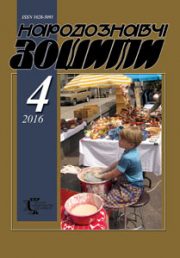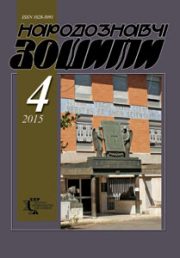The Ethnology Notebooks. 2024. № 4 (178), 883—893
UDK 7.046:271.2-526.62″10″
DOI https://doi.org/10.15407/nz2024.04.883
KOMARNYTSKY Andrii
- Candidate of Art History,
- Co-head of the Icon-Painting workshop «Alipiy»,
- Member of the National Academy of Sciences,
- 1, Maidan St. Pope John Paul II, 79070, Lviv, Ukraine,
- Contacts: e-mail: eny_andriy@ukr.net
Abstract. The article is about one of the rather iconic and, at the same time, unique works of the Kyiv sacred tradition. The appearance of the Kyiv icon «Our Lady of the Great Panagia», which is atypical in terms of style and iconography, testifies to the development of rare forms of Mother of God spirituality in the Kyiv state. Indeed, in the spiritual and sacred tradition of the 11th century, the image of the Virgin Mary was dominant in combination with Sophian ideas, which provided special significance to the aesthetics of light. The active role of the light principle largely determined the essence of this Virgin Mary appearance. This encourages us to clarify the root causes and historical prerequisites for the embodiment of a whole complex of such qualities in this icon, reflecting the ideal of the Virgin Mary, which was formed exclusively in the context of the historical era of enlightened and optimistic Christianity.
The general complex of original stylistic and iconographic features of the Great Panagia irrefutably testifies to the ethnocreative nature of the interpretation of the Mother of God image. As a product of the elite environment, this icon had the status of the patroness of the princely house and protector of Kyiv. This goes in line with the ethnic consciousness of the historical existence of the Kyiv state, where the Mother of God, like Wisdom, are the most significant symbols of the sacred state, the kingdom protected by God. Therefore, Our Lady of Oranta, as well as the Sign, were not only the central image of Kyiv churches, but also a national symbol and the «sacred palladium» of the Kyiv state. The idea of national protection or patronage occupied a special place in Kyiv spiritual culture.
Such an idea could be formed in Ukraine-Rus’ only under the conditions of a successful state that was aware of its own mission. And the main protective symbol in the princely period was precisely the image of Oranta or the Sign. It was these signs in the perception of the Virgin Mary that were important for the princely Kyiv Christian consciousness. Consequently, the article emphasizes the analysis of the problems of that era, which was an organic environment for the emergence of a sacred work called «The Great Panagia».
The purpose of the article: it is important to find out how and in what way the Kyiv icon of the «Virgin of the Great Panagia» reflected and combined ethnic manifestations of the sacred tradition with the ideas of national protection. What contributed to this combination. Along with the characteristics of ethnic characteristics, we will explore the problems of attribution and dating of this rare icon. The methodological basis of the study is the principle of historicism in combination with the structural-typological method and the method of art historical analysis.
Keywords: Great Panagia, All-Holy, Sign, Emmanuel, patronage, sacred tradition.
Received 8.07.2024
REFERENCES
- Ovsiiuchuk, V.A. (1996). Ukrainian Painting of the 10th—18th centuries. Problems of Color. Lviv: Institute of Folklore of the National Academy of Sciences of Ukraine [in Ukrainian].
- Komarnytskyi, A. (2024). Formation of Sophia and the Mother of God consciousness in the Kyiv centralized state under the first Christian princes. Ethnology notebooks, 2 (176), 456—461 [in Ukrainian].
- Komarnytskyi, A., & Zyatik, B. (2019). Shrines of Princely Ukraine. Lviv: Svichado [in Ukrainian].
- Lohvin, H.N. (2001). Kyiv Rus: monumental art, icon painting, book miniature. History of Ukrainian culture: in 5 vol. (Vol. 1, pp. 884—920). Kyiv: Naukova dumka [in Ukrainian].
- Antonova, V. & Mneva, N. (1963). Catalog of Old Russian icon paintings. Survey of historical and artistic classification. 11th — the beginning of the 15th century (Vol. 1). Moscow [in Russia].
- Krvavych, D., Ovsiychuk, V., & Cherepanova, O. (2004). Ukrainian art: textbook. Manual (Part 2). Lviv: Svit [in Ukrainian].
- Hilarion of Kyiv The word about law and grace. Retrieved from: Litopys.org.ua/ oldukr /ilarion.htm [in Ukrainian].
- Vereshchahina, N. (2019). Christian cults and relics of ancient Kyiv (end of the 10th — first third of the 13th century). Monograph. Odessa [in Russian].
- Alexandrovych, V. (2010). Protection of the Mother of God: Ukrainian medieval iconography. Lviv: Institute of Ukrainian Studies named after I. Krypiakevych of the National Academy of Sciences of Ukraine [in Ukrainian].
- Komarnytskyi, A.S. (2022). The icon «Our Lady of the Great Panagia» is a unique evidence of the spiritual and cultural values of Princely Ukraine-Rus’. Patriarchy, 1 (489), 35—39 [in Ukrainian].
- Komarnytskyi, A.S. (2016). On the way to innovation: the icon of Our Lady of the Great Panagia and the Kyiv tradition of mosaic images of Oranta. Kyiv Sophia: Byzantium. Rus. Ukraine (Issue V, pp. 282—301). Kyiv [in Ukrainian].
- Kosiv, R. (2021). Ukrainian iconography of the Mother of God. Lviv: LNAM [in Ukrainian].
- (1998). Kyiv-Pechersk Patericon. Kyiv: Academia [in Ukrainian].
- Miliaev, L., & Helitovych, M. (2007). Ukrainian icon of the XI—XVIII centuries. Kyiv [in Ukrainian].





